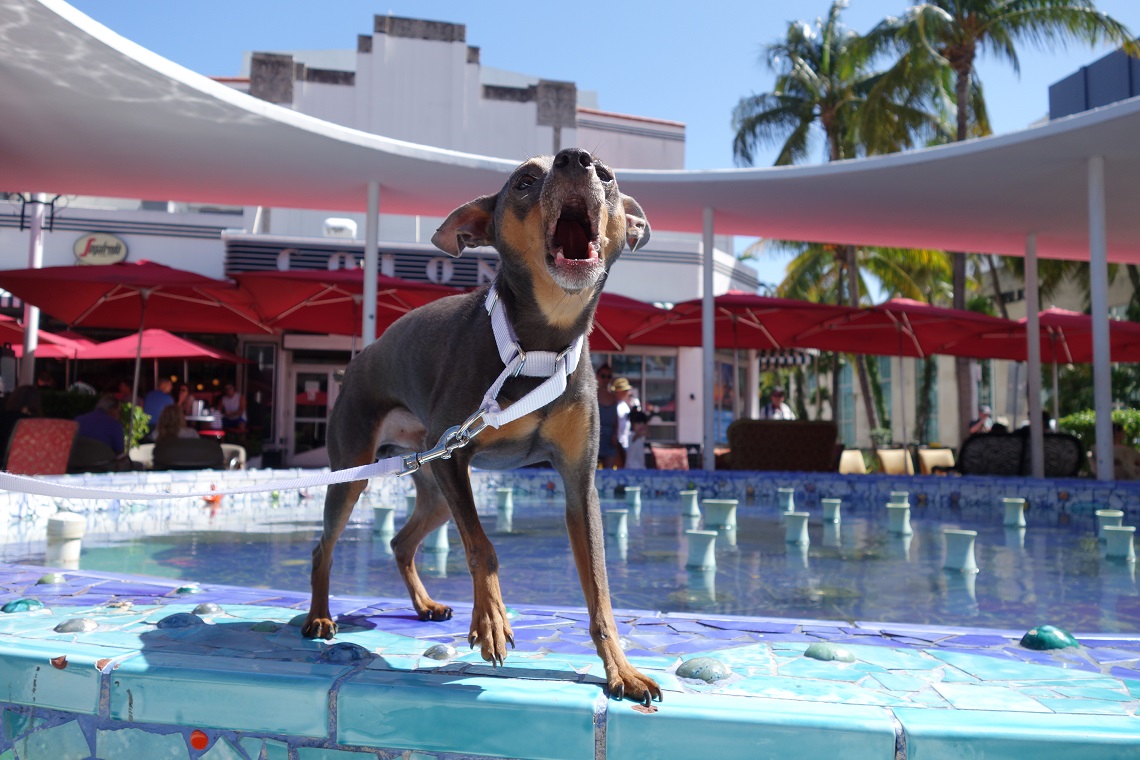
Dog Barking Causes And Solutions
Here are all of the dog barking equipment, collars, harnesses and pet products that we recommend
Poor dog behavior, especially dog barking, is stressful for everyone and can cause a dog to be rehomed or a parent to be evicted or fined. It surely isn’t a way to make friends with neighbors. Dog barking can also lead to other dog behavior problems such as dog biting and other dog aggression issues or be a symptom of a dog’s separation anxiety or a puppy that has to go potty.
Regardless of the cause, it is mandatory to stop dog barking not with a punitive dog bark collar but instead with positive reinforcement dog training.
Severe cases of dog barking are best addressed in our one-on-one custom Los Angeles Boot Camp where a Certified Behaviorist and Trainer can work with your dog’s anxiety and barking directly and intensely for longer periods while boarding and training.
Hearing loud, abrupt, sharp, and continuous noise is startling, and chronic dog barking can be damaging to a person’s and a dog’s mental, physical, and emotional health. Weakening the immune system and making a dog and person more susceptible to disease and sickness.
Getting rid of a dog barking completely is unreasonable, unlikely and just as unhealthy as chronic dog barking.
Dogs use auditory signals to communicate with one another and to express their emotions. Many dog breeds are bred to bark to alert others about their findings or to signal others at the sign of an intruder.
But first, before we get to the solution on how to get a dog to stop barking (bark less), we have to know why your dog is barking in the first place.
Healthy dogs don’t bark incessantly. As mentioned above, many dogs and breeds are specifically bred to bark to alert a person of an intruder, someone in their home, or in a dog’s territory. Also, dogs bark because it is a natural, enjoyable, and self-rewarding behavior. However, those are the obvious reasons a dog barks. Here are some other reasons dogs bark.
Why A Dog Barks
- Attention seeking behavior
- Boredom or Loneliness – dogs are not pack animals but they are social gregarious animals and experience separation distress/isolation distress, not to be confused with dog separation anxiety
- Genetics and they are bred to bark
- Territorial barking
- Alarm Barking
- Fear, anxiety, and stress
- Displacement behavior to ease a dog’s nerves
- Aggression barking warning others to give a dog space
- Socially facilitated barking, when your dog is with other dogs play barking
- Changes in environments. Environmental contrast or greeting barking
- Arousal/excitement barking
- Learned/reinforced conditioned behavior
- Barking is a fun self-reinforcing behavior
- Frustration Dog Barking, when your dog is frustrated, on a leash, behind a baby gate or barrier or can’t reach his friends or family he will bark
- Barking is a way to communicate with other dogs and animals
- Barking because your dog has to go potty
- A dog is hungry, thirsty or wants a toy
- When your dog is overtired and/or stimulated
You are likely not reading this article if your dog barks once in a while, you are here because your dog barks all the time or seemingly non-stop.
How To Stop A Dog From Barking
First things first, is to get your dog a full medical exam to make sure your dog has a clean bill of health and to rule out chronic pain, illness, or barking caused by old age or separation anxiety. Each one of the reasons mentioned above for why a dog barks would have a potential different dog training solution and behavior modification protocol to get your dog to stop barking.
Dog Barking is often a complex, contextual behavior done only in certain situations or environments. When your change your environment your dog’s behavior (barking) changes.
Dog barking is healthy, however, a dog that incessantly barks is not healthy and is very stressful for you and your dog.
How to stop a dog from barking is one of the most common questions I receive. To stop a dog from barking, just like with treating separation anxiety and many other dog anxiety cases, there are no one-solution fixes or one-size-fits-all approaches. Typically it takes trial and error by trying a combination of the following.
- Enrich your dog – an under-enriched dog is a bored, unfulfilled, unemployed dog that will look to entertain itself. Enrichment encompasses all of the following health factors. Socialization, play with other dogs and people, exercise, mental stimulation, dog training, healthy nutrition, novel experiences, rest, emotionally fulfilled, autonomy, etc. Here are further ideas to meet your dog’s needs in all of these core areas.
- Hire a dog walker
- Hire a pet sitter
- Feed and/or hydrate your dog (try using food-extracting toys). Feed your dog healthy dog food and dog treats. Stuff Kong toys with his favorite treats and or any food-extracting toy or items that he loves or that he only gets while in the crate.
- Take your dog to work with you
- Block a dog’s visual line of sight if something outside is visually triggering for her. It is always more important to stop a dog from rehearsing poor behaviors than to forget to reward good behavior. If your dog rehearses any poor behavior, it will get stronger.
- Place a blanket over the crate/X-pen or on different sides of the crate (making sure a dog has ventilation in the crate)
- Your dog needs to be enriched and fulfilled throughout the day just as we do. Use common sense. If your dog is scared of dogs, don’t take her around other dogs, etc.
- Exercise your dog
- Set up play sessions with dogs in safe environments
- Make sure your dog is comfortable and able to rest and sleep in a quiet comfortable Zen area, with a variety of comfortable dog beds, crates and environments just as we have
- Introduce your dog slowly and positively to novel stimuli and environments
- Practice positive reinforcement dog training to form a loving connection with your dog and give them some alternative behaviors to practice instead of barking. Like being quiet (more on how to do that below)
- Groom your dog, and give them lots of love and attention. The caveat is to not give them attention by responding immediately (under two seconds) to pushy behavior or dog barking. Provide petting and attention when your dog is behaving or quiet. Or at the very least when there is a few-second lull in your dog’s barking.
- Dogs love feeling safe and having routines. Put your dog on a routine for exercise, feeding, walking, training, sleeping, etc.
- Change your dog’s environment, including temperature, lighting, sounds, blankets, beds, music genres (and volume), white noise, crate and/or X-pen position/orientation, rooms, dog-appeasing pheromones (DAP), scents (aroma therapy diffusers, candles, incense), etc.
- Use an X-pen or dog crate (if they are positively conditioned)
- Introduce dog supplements that help soothe an anxious dog who is nervous, jittery, or fearful
- Take him out of the crate and put him in an Xpen or vice versa
- Turn on or turn off the television
- Open or close a door or window/shades
- Speak with a veterinarian behaviorist about changing your dog’s medication and/or supplements because they might not be working, dialed in properly or at the tail-end of their cycle
The goal is fully meet your dog’s needs, prevent fear, anxiety, stress, and arousal and to create any type of environment and mindset switch. This typically changes the environment enough to where a dog stops barking.
How to Train Your Dog Not To Bark
If you focus on enriching your dog as mentioned above, this will likely reduce your dog’s barking considerably!
However, here is one way to operantly train your dog not to bark.
Ironically and perhaps counterintuitively, for dogs that bark all the time, we first need to train your dog to bark. I know, sounds crazy but hear me out.
Barking is great fun when it is taught to a dog. Many parents are shocked to learn that in order to train a dog to stop barking sometimes it is appropriate and much easier to reward them for barking! you might be wondering, “Why in the world would I want to reward my dog for barking?”
Because after you put that behavior (barking) on cue you simply ask for it much less! Notice I didn’t say you never ask for it again. It is healthy, appropriate, and important for a dog to have a constructive outlet to bark, but barking under stimulus control or on cue discrimination is much healthier and easier to live with than a dog who decides on their own when they want to bark.
I would rather you choose when you want your dog to bark, not the dog.
A discriminative stimulus is any event in the presence of which a target behavior is likely to have consequences that affect its frequency.
After you put the discriminating stimulus (barking) on cue, you ONLY reward the dog barking when you ask for it, and not at other times. Putting a cue on stimulus control works magic because now your dog is getting rewarded for barking, but only when you ask her to bark. If your dog barks without you asking her to then you simply ignore your dog as if they do not exist.
Then, after there is a lull for a few seconds between barking, ask your dog to do an alternative behavior that is incompatible with barking, such as tug of war, scavenging for food, playing with chew toys, licking peanut butter out of food stuffed Kong toy, etc.
For the example above let’s assume we are going to name the verbal barking cue, Speak. Let’s also assume you have already charged/conditioned a marker/clicker (sound or word) so that your dog understands you and you are communicating efficiently and effectively.
For the following example, I use the marker, Yes.
How To Get A Dog To Stop Barking
- When your dog barks, say, “Yes!”, excitedly, then immediately (in 1/2 a second or less) and contingently reward your dog for barking with high-value dog training treats. Repeat for 10 trials.
- Now, say the cue Speak, directly before your dog barks. After you say Speak, your dog barks, immediately reward your dog for barking with high-value dog training treats. Repeat for 10 trials.
- Increase the time/duration in between your dog barking (when your dog’s Quiet) by saying the cue Good (for duration) as your dog is Quiet then after a few seconds, mark your dog’s Quiet with an excited, “Yes!” and treat.
- Say Good as your dog is Quiet for a few seconds at first (or the most amount of time you can get out of your dog without him barking) then click and treat. Continue to do this while increasing the duration of Quiet between each bark by saying Good when they are Quiet. Do this slowly, if you jump from 2 seconds to 20 seconds, it may be much too large a jump in criteria to ensure your dog understands and is successful. This is known as successive approximations or shaping a dog’s behavior and is the training protocol used for every learned behavior.
- Begin to put in duration (time) for the new cue Quiet in between each bark, only rewarding dog barking when you ask for it with the cue Speak and ignore barks where you don’t ask for anything. Ignoring includes eye contact, speaking, petting, laughing, etc.
- As the duration between your dog’s barks begins to expand, begin saying a new cue, Quiet, when your dog is not barking or when they are resting. For example, if your dog is lying down relaxing, say the cue Quiet, walk over and pop a wonderful high-value dog training treat into his mouth.
- Capturing your dog’s silence over and over throughout the day and keep expanding the duration that your dog is Quiet.
Voila, now you have a dog that doesn’t bark often. However, mind these dog barking training caveats.
- Do not stop rewarding your dog for barking once in a while as it is fun, rewarding, and natural. You are not trying to extinct barking altogether, just stop the unhealthy incessant barking.
- Do not repeat cues, say them once and that’s all. If a dog doesn’t respond after you say the cue once, simply take a deep breath, count to 5, and ask again. If you repeat yourself it will be counterintuitive to training and make your dog confused, sloppy, and only respond to you after you say a cue several times.
- Perhaps the most important part is to not reward your dog when they are barking if you didn’t ask for it. That is the most difficult to do for some pet parents because most parents are not aware when they are rewarding their dog. If you yell at your dog “No!”, or even look at your dog, those may all be reinforcing to your dog. Remember, any attention is better than no attention. Don’t reward your dog in any way and then begin the above protocol the moment they are Quiet and stop barking.
- Even the most chronic barkers have a lull in barking for you to begin Speak/Quiet training. All you need is a few-second gap between the bark and breathing for you to begin practicing.
- Lastly, if your dog is not over their threshold of fear or over-aroused, and your dog barks at a person or dog, you can try tossing some of your dog’s favorite treats on the ground directly before your dog begins to bark. The second a dog sees the stimulus that causes/triggers barking, before they bark, mark that with an excited, “Yes!” and toss several high-value pieces of food on the floor. This is a version of Look At That protocol.
Get Professional Dog TrainingHelp
Your dog is a unique individual and each case is contextual and situational. It is impossible to give across-the-board expert behavioral advice about any dog behavior. However, teaching a dog what you want from them through positive reinforcement obedience training in conjunction with understanding why your dog is barking and moving further away from the stimulus that may be arousing your puppy is a good start.
Additionally, a counterconditioning and desensitization protocol in conjunction with an understanding of ethology and obedience training would help stop a dog from barking and more importantly stop a dog from wanting to bark while teaching them an alternative behavior such as Quiet. If you are still having trouble or have a unique situation, call someone such as ourselves who are Certified Fear-Free Trainers and Behaviorists with years of modifying dog behaviors.
We are dog barking training specialists and have been successfully helping parents stop dog barking for decades. Whether you are in the Greater Los Angeles area or are living across the globe, fill out this short form for an expert Certified Dog Behaviorist and Trainer to help you with your dog’s barking and training today.



